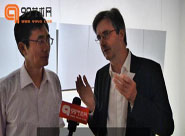From back to forth——About the structure of Yang Liming’s paintings and their inhering elements of musical forms
Entering Yang Liming’s studio in Beijing evokes strong impressions. The 2009 working series of dark paintings build a mysterious appealing ambiance in the spacious working place. The monochrome paintings at a first glance turn out to be dense interactions of lines and traces of scripture. Subtle lines, based on calligraphy, bring density into his canvas and build the microstructure of his works. A schematic drawing preliminary to the work on the canvas determines the framework for every painting, the macro structure and strong constant. The ground forms are clear and simple divisions of the canvas. In the recent works spatial forms are leading into each other which are building impressive spaces.
Even though there are no classical “horizons”, each of Yang Liming’s paintings has a horizontal slope line: the virtual break point separating the vertical ground from the dark matter, permitting the space to emerge. The scene generated from this configuration represents the virtual place of the painter’s world, his thoughts and emotions, implemented into the complex ensemble of the work itself.
For the observer it is impossible to see which color comes out of which one unlike recognizing the base, the original tonality from which the calligraphic structure had been rising from.
Yang Liming likes to listen to classical music in the studio. The assumption, that music plays a role during his painting process seems plausible but what is even more interesting is to discover the musical elements in his paintings. His brushstrokes seem to follow a rhythm in a certain regularity, resulting to a constant growth of the structure and maybe some music serves as an impulse for the artist during the painting process.
The unique facet in Yang Liming’s paintings is their way of being built up. The observer needs to “read” his paintings in a three dimensional way. Like an optical “lattice structure” his paintings emerge from “back to forth”, which is not only meant in the obvious logical sense, from its background more and more to the painting’s surface. Comparable with a sculpture whose surface is more and more moulded the three dimensional space is being built up. The paintings have a plastic character and effectively by this development of the approaching three-dimensional form, the possibility for different sound conceptions is given. Interior spaces are emerging which contain a level of time: the indefinite moment enabling musical impressions.
Musical notation effects in a vertical, or in some contemporary compositions a horizontal perspective and, while looking for musical elements, one is tempted to proceed in the mentioned way. In Yang Liming’s paintings the association with musical sound occurs in the generated space. The space in the canvas is vibrating through the calligraphic lines, releasing a high dynamic potential.
Speaking of the musical forms in Yang Liming’s paintings the interest is to assume which kind of music is inhering in his works and where parallels between the two media could be accumulated. Some ideas of dynamic and transparent melodies come immediately into mind. The structure of Yang Liming’s paintings is vibrating and full of tension, his statements, being transformed into his own calligraphic language.
Visualizing Yang Liming’s microcosm of independent lines, a self evident parallel with Györgi Ligeti’s Atmosphères occurs. This work for 55 string instruments, with all of them playing a separate voice was composed in 1961. Likely to Yang Liming’s big paintings with their dense content, the interacting clusters in Ligeti’s music are building up a fibrous structure over the formal ground, embodying a radical gesture of negation to the extent that it effaces most of the elements defining the traditional musical work, such as melody, harmonic progression, and distinct rhythmic patterning. It can be the melody line of a violin which is setting oneself apart from the sound of the orchestra or a vibrating sound development in an instantaneous string quartet.
Yang Liming’s paintings are abstract. Each one of his many independent lines contains a calligraphic message, even though they are not aligned to each other. The density in Yang Liming’s paintings evokes a direct comparison with the many independent voices in Ligeti’s Atmosphères. Both oeuvres emerge from many single voices, all playing their own part and so through unhomogenety constructing a field, negating the common terms as well of musical as of optical composition by generating their own intern specifics.
The first association with Yang Liming is probably the negation of time and thereby the occurring feeling of stasis in both works, which gives a feeling of deep space and timelessness. Ligeti himself said that he intended the listener to become lost in the depth of the texture and tone and become completely oblivious to the passage of time. A similar sublimation of time during the moment of looking at Yang Liming’s paintings brings the ideal situation of their reception, finishing the fulfilled circle of thoughts with their musical forms emerging in those moments.
To both works, Yang Liming’s paintings from the last years and Györgi Ligeti’s Atmosphères (and other works as for example Lontano, Apparitions), the first impression is a hermetic closed form into which it is difficult to enter. Yang Liming’s monochrome fields of color seem to have their acoustical equivalent at the first compelling, vibrating impression of Atmosphères. At closer view the fields break open and the many lines as well as the different instruments become perceptible.
The spectacular and the listener need to find their approach or rather need to adjust to the work so that it can reach him, likely a microcosm which is after this process of adjustment becoming accessible. For Yang Liming as well as for Györgi Ligeti emotions are something that is codified in their oeuvre, carefully hidden behind the interaction of voices and lines, not laying open. By closer consideration these emotional aspects may become visible.
Yang Liming’s paintings are abstract, in the same time having a stable, firming ground structure. Nevertheless, by closer perception there are many different aspects, parts that show reflection, sigh and some light moments of joy. Here is maybe the point to connect with Franz Schubert’s music with its delicate points like open wounds, melancholic meditations of questions without answers given. Yang Liming’s paintings take the viewer into their deep universe, in case the viewer permits to be carried away. Just as well as in Schubert’s music are questions rising, involving the observer into their matter. What is melancholia in Schubert’s music stays as a mystery in Yang Liming’s paintings.
The lines in Yang Liming’s paintings could be seen as “melody lines”, as themes and their development through a musical piece. In Schubert’s music the melody lines transport questions and hope but as well the unique beauty in the composition. Yang Liming’s lines contain his thoughts that are transferred into a direct expression through calligraphic lines. He speaks in an interview about “the inside and outside of man which are mirror worlds”[i]. His inside worlds, meaning his thoughts and emotions are transferred ‘outside’, into his paintings, but they have been transformed into his language of calligraphic lines. In comparison of his paintings with Schubert, the just so called “abstract” paintings become a classical aspect. By seeing the parallels with Schubert, the melodic parts of his works emerge, showing the high esthetical potential inhering in his paintings.
Yang Liming’s aim in a painting is similar to the idea during composing a musical piece, to shorten up the path from his thoughts to the canvas. The more direct, the clearer his expression is the better. The practice of calligraphy is the technical part, forming the skills to perfection of the thought expression-line.
Through coactions of the personally charged calligraphic lines, his paintings connect with Györgi Ligeti’s sound clusters of different voices. In the same way they contain melodic elements bringing them close to Franz Schubert’s music. The two different mentioned parallels are only examples to show the versality of Yang Liming’s paintings which contain in the same time a classical facet and the evident contemporary context.
Alexandra Grimmer July 2009
[i] Yang Liming in an interview with Ouyang Jianghe in his catalogue published by Triumph Art Space, 2008, p.12.
【Editor:jen】

